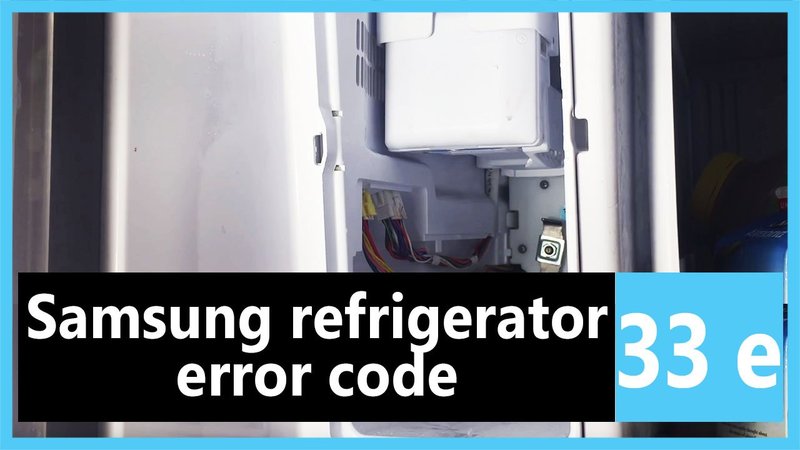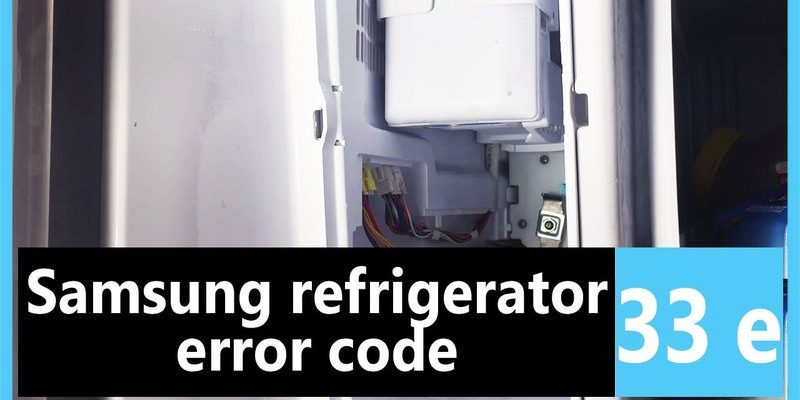
When a Samsung refrigerator displays an error code like E3, it’s essentially trying to communicate with you—similar to how a car’s dashboard lights up when something needs attention. In most cases, getting an error code can be unnerving, almost like your fridge is speaking a language you don’t understand. But don’t worry! An E3 error might not be as bad as it seems, and your kitchen companion could just be signalling a need for a little TLC.
Understanding the E3 Error Code
What exactly does the E3 error code mean? In layman’s terms, it’s an alert from your refrigerator about a malfunction in the defrosting process. Think of it like a traffic light turning yellow—it’s a signal to pay attention. The defrosting mechanism in your fridge helps prevent frost build-up by occasionally warming the coils to melt any ice formation. If this system fails, your fridge could start building up frost like a snowstorm in the freezer!
Now, you might be wondering, why is defrosting so crucial? Well, without it, your refrigerator can become less efficient. Excessive frost can insulate the coils, making it harder for your fridge to maintain the desired temperature. It’s like trying to keep a room warm with all the windows open—your fridge works overtime, and your energy bill might start climbing.
If you see an E3 error, don’t panic. It doesn’t mean your refrigerator will suddenly stop working or become a hazard. However, it does suggest that something’s amiss, and it needs your attention. It’s your fridge’s way of saying, “Hey, buddy, a little help over here!”
Causes and Effects of the E3 Error Code
So what causes this error to pop up? Typically, the E3 error code is triggered by issues with the defrost heater, the defrost thermostat, or the control board. Imagine these components as the members of a band. If one instrument goes out of tune or stops playing, the music doesn’t sound right. Similarly, if one part of the defrosting system falters, the whole process can get thrown off.
To give you a clearer picture, the defrost heater might fail to start, leaving ice to accumulate. Meanwhile, the thermostat might fail to signal when defrosting is needed, or the control board might not be coordinating these cues effectively. Each plays a vital role, and a hiccup in any of these parts can lead to the dreaded E3 alert.
But what about the effects? If left unchecked, increased frost can lead to poor cooling performance. Your freezer might resemble an igloo, while the fridge section struggles to stay cool. This isn’t just inconvenient—it can shorten the lifespan of your appliance and increase energy consumption, much like a marathon runner trying to sprint with a heavy backpack.
Is It Safe to Use Your Refrigerator With This Error?
The big question on your mind: Is it safe to continue using your fridge with this error code? Generally speaking, it’s safe in the short term—your fridge won’t explode, and your food isn’t in immediate jeopardy. But ignoring the problem isn’t a good long-term strategy. Over time, the efficiency of your refrigerator will decrease, and you may notice your food spoiling faster than usual.
Think of this error like a “check engine” light in your car. The vehicle might still run, but it’s a warning that something could go wrong if neglected. Similarly, continuing to use a fridge with an E3 error might lead to more significant issues, such as motor strain or higher utility bills. It’s better to address the problem sooner rather than later.
If you notice this error, a good next step is to consult the user manual or reach out to a professional technician. Samsung offers customer support, and in some cases, a simple reset or part replacement might solve the problem. Remember, it’s not just about fixing an error but maintaining the longevity of your appliance—a bit of prevention goes a long way.
Taking Proactive Steps to Prevent the E3 Error
While technical issues can’t always be predicted, there are steps you can take to minimize the risk of encountering the E3 error. Regular maintenance is key, much like going to the dentist for a check-up to catch potential issues before they become problems.
You can start by ensuring the vent areas in your refrigerator aren’t blocked by food items, which promotes proper airflow. Imagine trying to breathe through a stuffy nose—it’s similar for your fridge when airflow is restricted. Regular cleaning of the interior and exterior helps too, as well as defrosting your freezer if ice buildup becomes noticeable.
If your refrigerator is older, consider having a technician inspect the defrost system annually. This proactive measure is like getting your car serviced—catching small issues before they evolve into costly repairs. And while you’re at it, verifying that the door seals are intact ensures cold air remains inside, keeping everything running efficiently.
In summary, while the E3 error code might seem daunting at first, understanding and addressing it is straightforward. By keeping an eye on your appliance and taking some preventative measures, you can ensure your refrigerator remains a trusty kitchen companion for years to come.
